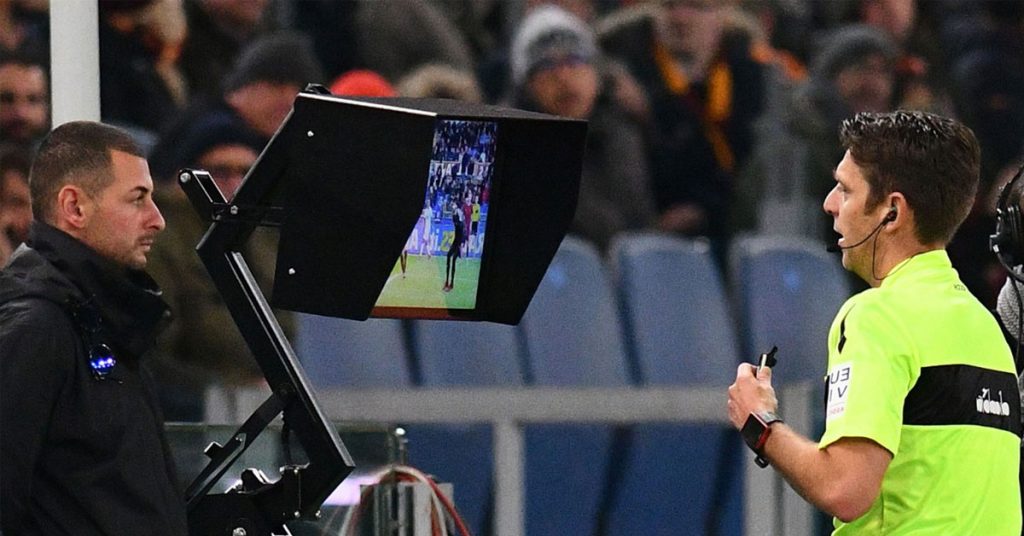Some will say Video Assistant Referee (VAR) is another of the greatest innovations in football, next to Goal-line Technology. We’ve seen it used in the FIFA 2018 World Cup, Russia, and the English Premier League has finally adopted VAR in the 2019/2020 football season. Yet, football lovers still debate the pros and cons of VAR. Should more major leagues adopt VAR? Should the International Football Authority scrap it out completely?
FIFA is continually working on ways to make the football game fair and they are not overlooking technological advancements. While VAR technology may be a new introduction to the game, it is gaining more acceptance. FIFA adopted it for the 2018 World Cup, UEFA implemented it from the 2018/2019 Champions League Quarter Finals, and the English Premier Leagues have recently adopted it.
What is your say, is VAR a good introduction to the football world or not?

Table of contents
What is Video Assistant Referee (VAR)?
As the name suggests, VAR officiates the match with the football referee, only VAR does not run around the pitch with the referee. VAR sees, however, through the camera lens. The video companion guides the human referee to make decisions as he may not have clear evidence to guide his judgment.
The VAR journey started in early 2010 through the Refereeing 2.0 project. The Royal Netherlands Football Association (KNVB) championed this cause. Through mock trials, the association tested the VAR system in the 2012-2013 Netherland League (Eredivisie) season. The tests proved satisfactory, but the former FIFA president, Sepp Blatter, who was averse to introducing new technology to football would not look into it.
KNVB petitioned the International Football Association (IFAB) in 2014 to amend its football laws to allow the VAR system to be used during more extensive trials. It wasn’t until See Blatter was removed from his seat as FIFA president due to corruption in 2015 that IFAB finally approved VAR systems for extensive testing. IFAB approved the VAR for extensive testing in 2016, affirming that with all the present technological sophistication in the stadia they needed to protect the referee from making mistakes that everyone can see.
The International football body warmly accepted the VAR proposal under Sepp Blatter’s successor Gianni Infantino. After its first use in Australia in 2017 in a match between Melbourne City and Adelaide United, as well as acceptance in major European leagues, IFAB wrote VARs into the Laws of the Game.
They wrote the VAR system to operate under the philosophy of “minimal interference, maximum benefit.”
When is VAR Used?
According to FIFA, referees fall back to VAR in three main incidents, plus one administrative incident.
VAR assists the referee to determine whether to award a goal or not.
Secondly, VAR helps the referee to make the right penalty decisions. Often, there is a long deliberation to make before the referee awards a penalty. VAR ensures that the referee does not give a penalty wrongly, as well as calls back the referee’s attention to a penalty they missed.
Thirdly, VAR ensures referees make the correct direct red card incident decisions in a football game. It saves the referee from sending off a player for an offense the spectators clearly see the player did not commit.
Finally, VAR saves the referee from the mistake of mistaking a player’s identity and sending off the wrong player from the football pitch. When the referee is unsure of which player to sanction, VAR comes to his/her aid.
How does VAR work?
Here is how FIFA explained that VAR works.
- Incident Occurrence
When an incident occurs on the football field, the referee either informs the VAR or the VAR recommends to the referee to review a decision/incident.
- VAR Review Advice
VAR reviews the video footage and then advises the referee via headset what the video shows.
- Decision
The referee then decides to review the video footage on the side of the field of play before taking the appropriate action/decision. The referee accepts the information from the VAR, after reviewing it from his end, and takes the appropriate action/decision.
Pros and Cons of VAR in Football
Welcome the VAR vs Traditional refereeing argument. Which do you think is better, technological assisted refereeing in football or the traditional refereeing? This is a hot argument which we can’t ourselves draw a conclusion from. But whichever stance you’re taking in this argument, we hope to provide you enough backup for your points.
We will share with you the pros and cons of VAR in football. How it has helped the human referee make better decisions in the football game, or how it has completely ruined a football match. After reading our pros and cons on the use of VAR in football, you may now be able to make well a guided conclusion on the argument.
Pros of Video Assistant Referee
Below are some of the reasons football fanatics and stakeholders uphold that the Video Assistant Referee is a good introduction to the football game.
Top Level Acceptance
VAR has been in existence for a long time. Cricket and rugby have been using this technology for a long time. The football authority just couldn’t embrace it with wide arms, probably because of the controversy they felt it would create. However, today, top-flight football clubs around the world, including the English Premier League, use VAR. Also, for FIFA to adopt it in the 2018 World Cup in Russia, definitely means they found it to be of great utility.
Better Officiating
Players and teams’ careers have been ruined and winning chances lost because of poor decisions of referees. Do you remember Maradonna’s ‘Hand of God’ goal against England in the 1986 World Cup? Can you also remember Thierry Henry’s handball which allowed France to progress to the 2010 World Cup tournament? Do you see how England’s hope of winning was thwarted or how the Republic of Ireland would’ve qualified for the World Cup in 2010 instead of France? We may not see situations like this again in Football if VAR is used at all levels and regions of the football game.
Greater Entertainment
Do you also sit on the edge of your seat while the referee runs to the on-field monitor to watch the replay of an action? There is so much adrenaline running through the body while both teams argue and wait on the referee to either send off a player or award a penalty. This is an excitement that is new to the game which football fanatics are reveling in so quickly.
Cons of Video Assistant Referee
After VAR’s debut in the 2018 World Cup, FIFA proclaimed the technology a success. According to them, the VAR system had a success rate of 99.3 percent in the tournament, up from 95 percent of correct calls by referees without VAR. However, several football fanatics and enthusiasts weigh more cons of VAR than pros.
Here are people’s displeasures with the introduction of VAR to the football game.
Game Delay
FIFA’s policy of adopting VAR technology was “minimal interference, maximum benefit.” However, this has not exactly been the case in football matches where VAR was used. The referee doesn’t only spend a lot of time listening to the VAR team at the Video Operating Room (VOR) via his earpiece but also spends more time at the On-field Video Review station watching replays. It bores the fans who don’t like seeing the game paused for over a few seconds. It also stretches the duration of the game.
Subjective Decisions
It is somewhat a shame that after receiving the advice of the VAR team at the VOR and reviewing the monitor footage, the referee may still go ahead to interpret the situation in a way he thinks is best. It almost defeats the purpose of the VAR system and leaves one of the teams feeling cheated.
Lack of Transparency
In cricket and rugby, the public has access to the audio version of the conversation between the VAR officials and the referee, which aided the referee’s decision in the game. This is not the same as football. There is no way of knowing what transpired between the VAR team and the referee and it doesn’t seem like FIFA would approve of making this audio conversation available to the public anytime soon.
Less Controversy
Controversy may not be good, but it keeps the game going. When a game ends, people walk back home from the stadium discussing how a rough tackle hadn’t seen a player sent out of the football pitch. They discuss how a referee was either God-sent or hell-bound. Now, with the advent of VAR football fanatics almost have nothing to discuss in pubs.
What are Coaches, Players, and Commentators Saying about VAR?
Let’s further draw on some insights that would help you decide for yourself if VAR has more pros than cons in the football game.
Here are some of what people directly involved in the football game has to say about VAR.
We can see in the matches, where the game is being interrupted. This creates an additional moment of tension where everyone is waiting. Gianni Infantino
“VAR didn’t save us, it just told the truth.” Sergio Ramos
“VAR has to go both ways. Yann M’Vila“
2018 World Cup VAR Reviews
While FIFA has proclaimed VAR a success in the world cup at Russia, let’s look at how it really fared.
Goals
Regarding goals, here are the instances where VAR intervened.
Diego Costa in Spain versus Portugal – GOAL Saeid Ezatolahi in Iran v Spain – NO GOAL Iago Aspas in Spain v Morocco – GOAL
Penalty decisions
The first incident in the World Cup where the referee turned to VAR was a penalty incident. It was Josh Risdon’s tackle on Antoine Griezmann in Australia’s match against France. Even though the Uruguayan referee Andrés Cunha pointed to the spot after numerous replays and words from the VAR officials, it was hard to say whether he made the right call.
Other penalty instances – all of which the referee gave – include:
- Neymar against Costa Rica
- The foul on Sweden’s Viktor Claesson in Sweeden Vs South Korea
- Mohamed Salah in Egypt Vs Russia
- Gylfi Sigurdsson in Iceland Vs Nigeria
However, football fanatics and enthusiasts count some penalty instances – which the referees didn’t give – against VAR.
These instances include:
- Harry Kane in England Vs Tunisia
- Ronaldo in Portugal Vs Morocco
- Aleksandar Mitrovic in Serbia vs Switzerland
Red cards
VAR faced the greatest bias when it came to disciplining players in the world cup.
The instances which created controversy in the use of VAR regarding VAR include:
- Ante Rebic: Football lovers believe Croatian International should have been sent off for a studs-up, shin-high challenge on Eduardo Salvio during Croatia’s 3-0 victory over Argentina.
- Gerard Pique: In Spain’s game against the host nation, Russia, football lovers felt that Pique should have been sent out after handling the ball in the penalty box. The referee awarded Russia a penalty instead and Pique remained in the game.
Mistaken identity
In the France versus Peru game, a word in Mohammed Abdulla Mohamed’s ear led the UAE official to show Pedro Aquino a yellow card correctly. France defeated Peru 1-0.
VAR Review in Major Leagues
The English Premier League finally adopts VAR in the new 2019/20 season. We are all watching with excitement on how VAR affects English football. Will there be good reviews mid-season or will VAR receive heavy criticisms in England?
While we await that, let’s see how VAR has fared in other major leagues. Some big European clubs have been using VAR for officiating football matches as far back as the 2017/2018 season. Some others have only adopted it after the 2018 World Cup.
La Liga, Bundesliga, Serie A, Ligue 1, Primeira Liga, and MLS have used VAR for at least a full football season. In the following sections, we’ll share with you ESPN’s review of the use of VAR in these football clubs.
La Liga – Spain
Number of key incidents VAR reviewed in the 2018/19 Season: 364
Number of incidents VAR correctly overturned after review: 10 overturned. 354 decisions approved (97.2 percent)
The Spanish LA Liga used VAR in all 29 league games of the league. This averaged 12.55 reviews per game. In all of this, the referees reviewed only three incidents using the pitch-side monitor, while VAR recommended seven incidents for review. VAR assisted in overturning ten referee decisions after reviews – seven goals (five for offside, one for a previous foul and a goal/no goal situation), two penalty decisions, and one mistaken identity.
Bundesliga – Germany
There is no information yet on the total number of incidents VAR reviewed in the 2018/19 season. However, in the 2017/18 season, VAR overturned a total of 76 key decisions and 99.25 percent of these decisions were correct. Referees awarded 26 penalties after video review, and they reversed 13 penalty decisions. For that season, Referees also disallowed a total of 23 goals.
Serie A – Italy
There is no information yet on the total number of incidents VAR reviewed in the 2018/19 season. However, in the 2017/18 season, VAR correctly overturned 117 goals (59 penalties, 16 red cards, 42 goals) after review. The number of mistakes without VAR would have been 5.75 percent, whereas, with it, this dropped to 0.89 percent. Also, over the course of the season, the average time for VAR decisions improved from 1 minute 22 seconds in the first three games to 31.5 seconds over the whole season.
The Italian league is going on its third (3rd) year of using VAR, yet VAR still raises controversies. The league is not satisfied with its implementation, especially for offside decisions.
Ligue 1 – France
There is no information yet on the total number of incidents VAR reviewed in the 2018/19 season. However, the season started so well. In the season’s opening game, Marseille Vs Toulouse, VAR gave the hosts a penalty that sparked a 4-0 win. VAR was introduced in the league matches in France for the first time in 2018-19.
Primeira Liga – Portugal
There is no information yet on the total number of incidents VAR reviewed in the 2018/19 season. However, for the previous season, VAR correctly overturned 76 incorrect refereeing decisions – 34 rounds, 18 team league.
VAR technology was introduced to the Portuguese League in the 2017/18 season and it has been well accepted.
Major League Soccer – USA
Number of video reviews in 2018: 95
Number of incidents correctly overturned after video reviews in 2018: 68
Total Number of correct decisions following video review in 2018: 84 (includes initially correct decisions that were maintained and incorrect decisions that were changed).
The 2019 season makes it the second season of VAR in the MLS. However, coaches, players, and team executives still heavily criticize the system.
Conclusion
We all love to watch good football and while VAR is a good introduction to the game or not, FIFA has used it in the 2018 World Cup. The International organization has seen it as a good improvement to the game and may likely employ it in the next World Cup. However, this doesn’t mean that the VAR technology is entirely beautiful. If not the English Premier League wouldn’t have stalled this long before accepting VAR into the league. With the pros and cons we have provided you in this post, we believe you too can draw your own conclusions.
References
In the course of this research, we got information from the following sources:
- https://football-technology.fifa.com/en/media-tiles/video-assistant-referee-var/
- https://www.espn.com/soccer/blog/espn-fc-united/68/post/3624367/how-var-has-performed-in-la-liga-serie-a-bundesliga-ligue-1-and-mls-this-season
- https://en.wikipedia.org/wiki/Video_assistant_referee
- https://www.bbc.com/sport/football/44658757
- https://www.theguardian.com/football/2018/jun/26/var-world-cup-2018-verdict-so-far-sachin-nakrani
- https://www.safa.net/2018/07/09/opinion-piece-var-video-assistant-referee-pros-cons/
We Also Recommend:
- Pros and Cons of Sports Betting in Nigeria
- Major Football Injuries And How To Prevent Them
- The Impact Of English Premier League On Nigerian Youths
- Officials in a Football Game and their Roles
- Who is the greatest Super Eagles Captain? Achievements and Trophies
- Basketball in Nigeria: History, Academy, Organization, and Team
DISCLOSURE: This post may contain affiliate links, meaning when you click the links and make a purchase, we receive a commission.






2 comments
Comments are closed.